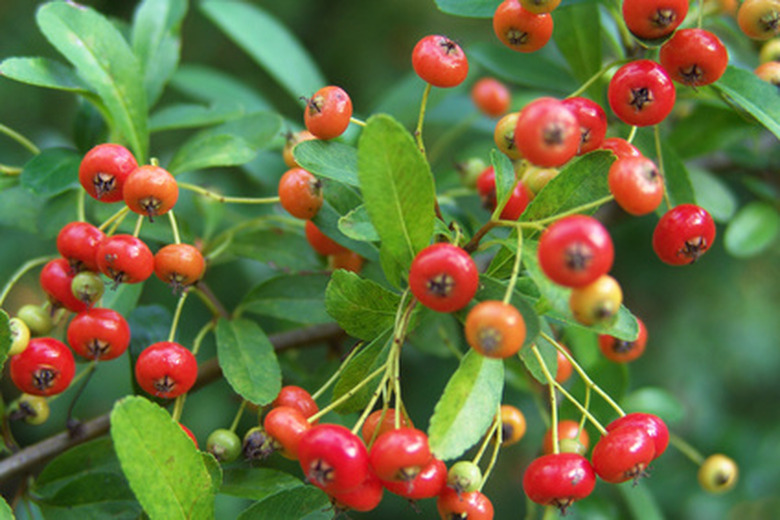Types Of Red Berry Trees
Green leaves are commonplace on most trees, but red berries among the leafy foliage provide a unexpected burst of welcome color. Most trees that sport clusters of ruby-colored berries don't offer edible bounties, and many are highly poisonous, but the colorful fruit brightens up the simple greenery of trees. A variety of both leafy, deciduous trees and needle-covered evergreens offer red berries that add colorful highlights to your landscape.
Berry-Bearing Holly
Holly (Ilex spp.) includes hundreds of tree and shrub species known for their waxy, toxic, red berries. With varieties hardy from U.S. Department of Agriculture plant hardiness zones 3 through 9, some are low-growing shrubs or indoor potted plants, but other species grow into impressively tall trees. The English holly tree (Ilex aquifolium), hardy in USDA zones 7 through 9, sports white flowers in the spring that give way the distinctive red berries as cold weather approaches. American holly tree (Ilex opaca), hardy in USDA zones 5 through 9, is distinguished from European hollies by its rounded, rather than spiny, leaves. Plant hollies where berries stay beyond the reach of children and pets.
- Green leaves are commonplace on most trees, but red berries among the leafy foliage provide a unexpected burst of welcome color.
- The English holly tree (Ilex aquifolium), hardy in USDA zones 7 through 9, sports white flowers in the spring that give way the distinctive red berries as cold weather approaches.
Red-Berried Yew
Yews (Taxus spp.) are unique conifers because, instead of the customary cones that define other conifers, female yew trees offer red berries. Depending on variety, they may be hardy from USDA zones 4 through 8, and bear small red berries that feature a distinctive hollow center. The soft portion of the berries is sweet tasting and nontoxic, but the berries also contain seeds that are poisonous to humans. Birds safely eat yew berries because their stomachs do not effectively break down the seeds to release the toxic alkaloid within.
Red-Fruited Dogwood
Dogwoods (Cornus spp.) include at least 30 different species of deciduous flowering trees that may be hardy from USDA zones 2 through 9. The woody flowering trees are common fixtures in public parks and gardens because of their showy spring flowers. After the petals have wilted and fall arrives, some varieties of dogwood trees present tight clusters of waxy red berries. Though some dogwood varieties offer edible berries, other varieties produce berries that are toxic to humans and pets. Avoid eating berries of any dogwood, or any other plant, unless you are positive of the precise variety and its safety.
- are unique conifers because, instead of the customary cones that define other conifers, female yew trees offer red berries.
Edible Red Tree Berries
Though many trees feature berries that are toxic to humans, some trees produce berries that can be safely eaten. Wonder trees (Idesia polycarpa), hardy is USDA zones 5 through 9, offer hanging clusters of small red berries that are tart, but safe to eat or include in cooking. The red elderberry (Sambucus racemosa), hardy in USDA zones 3 through 9, is notorious for toxic bark, wood and leaves. Like some other elderberries, the ripe red berries are harmful unless cooked. Processing makes them safe for jellies and pies. With all berry-bearing trees and shrubs, never eat the fruit unless you are certain it is safe. Teach children to do the same.
- Though many trees feature berries that are toxic to humans, some trees produce berries that can be safely eaten.
- Like some other elderberries, the ripe red berries are harmful unless cooked.
References
- Missouri Botanical Garden:Plant finder
- Nova Scotia Museum: Poisonous Plants: Elderberry
- The World Botanical Associates: Overview of the Genus Taxus
- USDA NRCS Plant Fact Sheet: Red Elderberry
- Tree Help: Holly
- Cyclopaedia of Edible Plants of the World; Tyozaburo Tanaka
